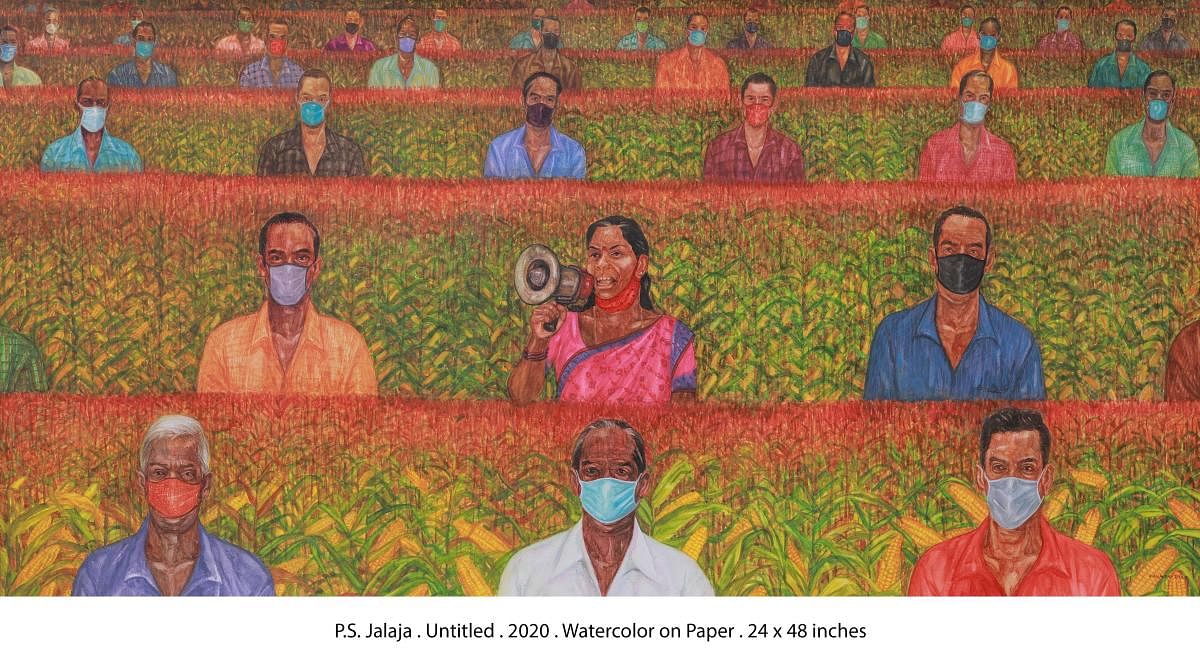
Today, everybody is talking about farmers because of the agrarian crisis and the mammoth agitation near the borders of Delhi. Otherwise, farmers are always either on the periphery of any discussion or are completely ignored. Farm produce is consumed by all, but farmers or agriculture has never been the focal point of any city dweller, except perhaps for the artist community.
Every artist — painter, potter or sculptor — all over the world has, sometime or the other, been influenced by agriculture, farm and rural life. In fact, the first drawings found in the caves represented farm life with animals and plants. Artists of the Paleolithic cave paintings and the medieval ages were more into farm-related art. Even cave paintings aged about 1,200 B C, especially those found in the Egyptian burial chambers, depict farming.
Icons of folk art
Till the Industrial Revolution in the 18th century, the main form of livelihood was agriculture, so every person, including artists, were influenced by it. Even today, where agriculture is the main source of livelihood, especially in the tribal and adivasi belts, their art has an influence of this element. And hence, folk art today too, largely concentrates on the representation of the elements of the earth. Every folk art, be it Warli of Maharashtra, Gond of Madhya Pradesh, Pattachitra of Odissa and West Bengal, Madhubani of Bihar, Kalamkari of Andhra Pradesh, Telangana, Miniature from Rajasthan, Chittaras from Karnataka and many others, including those from Africa, China and other nations with centuries-old history of human dwellings, have always portrayed different stages and activities of farming and farm life.
Even with the onset of the modern art phase in the 19th century in the West, we had almost every artist employ this subject. For example, Vincent Gogh (The Red Vineyard, The Irises, The Wheat Field with Crows), Claude Monet (Poppies, The Poppy Field, Grainstack), Jean Millet known for peasant farmers (Harvesters, The Angelus, Calling Home the Cows), Paul Cezanne’s (Fruits, Tulips, Landscape near Paris) and others always had a phase when they worked on farm or farm-related subjects.
A realistic depiction
Closer home, we have many artists from Bengal whose farm-related canvasses still come under the hammer at many auctions here and abroad. The difference between Indian and Western artists is that Indians represented the subject more realistically. The hardships, the rage of weather, the scene of famine were the most important themes, especially those who painted in the beginning of the 20th century, whereas most of the artists from the West, except may be Jean Millet, romanticised the farm subjects.
The stark reality of the hardship of farmers in the early 20th century can be seen in the charcoal and pencil sketches of Kolkatta-based artist Nandlal Bose (1882-1966).
A pioneer of modern Indian art and a Padma Vibhushan awardee, Bose, who illustrated the Indian Constitution, showed in his work titled In The Rain, two farmers walking under one umbrella carrying a wooden plough on their shoulders with farm tools and food bundles dangling from it. In another pen and ink untitled work, there is a malnourished buffalo and a farmer ploughing the land.
Chittaprosad Bhattacharya (1915-1978) was another Kolkata-based political artist who preferred water colours and printmaking and presented farms and farmers in all moods — hard and happy times. His main inspiration was rural life and his first-hand experience of the Bengal famine and harsh reality of farm distress was presented in a series of works created with ink on paper. Then we had Mumbai based Padma Bhushan awardee K K Hebbar, who, in few of his miniature style works, depicted village women plucking papaya, a woman leading a calf to her mother cow before milking and many others.
At present, many artists residing in small cities, continue to show their love of rural and farm life on their canvasses. Murali Nagapuzha from Trissur, Kerala, Santosh Bhoir, Bhiwandi, Maharashtra, Anup Khatua, Bengaluru, etc., represent this life in both contemporary and abstract styles. Farmers’ protests has also witnessed artists use their canvass as protest representation. As Mysuru-based artist N S Harsha, through his work, says, “In the name of development, an urgent encroachment into agrarian cultures and societies is an irreversible internal failure of ‘modernity.’”